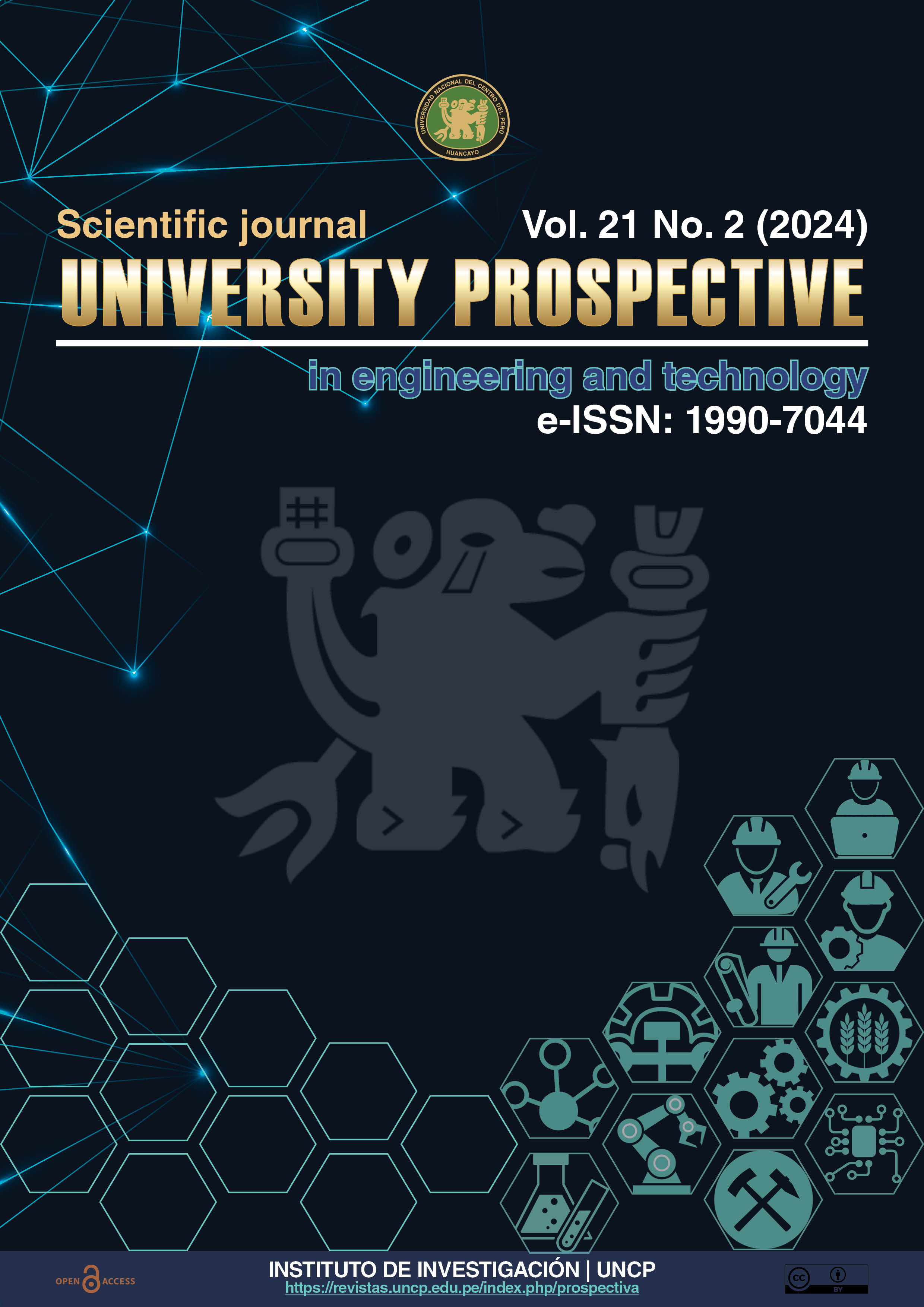Lighting comfort in elementary school classrooms in the Chorrillos neighborhood of metropolitan Huancayo
DOI:
https://doi.org/10.26490/uncp.prospectivauniversitaria.2024.21.2397Keywords:
lighting comfort, natural lighting, school classrooms, RNE-EM110 standardAbstract
The study analyzed the lighting comfort of classrooms in elementary schools in the neighborhood of Chorrillos, in Huancayo Metropolitano, during 2016. Objective: The aim was to determine the percentage of classrooms that met the lighting comfort conditions according to national and international standards. A non-experimental methodology with cross-sectional and descriptive design was used, evaluating the classrooms according to the National Building Regulations (2014) and the EM110 standard. Results: 75% of the classrooms reached general lighting comfort conditions. Specific values of 91%, 82% and 50% were obtained in different evaluated areas. The lighting levels recorded averaged 645 lux, with a minimum range of 250 lux and maximum values of up to 1788 lux, complying with the EM110 standard. However, the Peruvian standard is lower than that of other countries such as Argentina, Brazil, Australia and Belgium, where minimums vary between 300 and 500 lux and maximums between 500 and 750 lux. Although the classrooms analyzed present adequate lighting levels according to local regulations, the lack of definition of a maximum range in Peruvian regulations contrasts with international standards that consider the negative effects of excessive lighting, which could be reviewed to improve lighting comfort in classrooms.
Downloads
References
Aliaga, K. (2023). Modelo de Gestión Y Administración de Proyectos del SSI en ejecución de obras del Gobierno Regional de Pasco 2022-2023. Universidad Nacional del Centro del Perú. https://repositorio.uncp.edu.pe/handle/20.500.12894/10795
Boyce, P. R. (2014). Factores Humanos en la Iluminación (Third edition). CRC Press, Taylor & Francis Group.
Cabrera, G., & Marquez, A. (2019). Evaluación del confort lumínico en aulas educativas en climas tropicales. Revista de Arquitectura y Urbanismo, 45-60.
Carrasco, S. (2008). Metodología de la investigación científica: Pautas metodologicas para disen̋ar y elaborar el proyecto de investigación (2a ed). San Marcos.
CIBSE. (2015). Guía de iluminación n.o 5: Iluminación para la educación.
Hopkinson, R. G. (1963). Física Arquitectónica: Iluminación. H.M. Stationery Office.
Martín, M. (2006). Calidad ambiental en la edificación para Las Palmas de Gran Canaria, Islas Canarias manuales de diseño ICARO: Vol. Manual de Iluminación. Ayuntamiento de Las Palmas de Gran Canaria.
Ochoa, C. E., & Capeluto, I. G. (2006). Evaluación del confort visual y el rendimiento de tres sistemasa de iluminación natural para edificios de oficinas profundos en climas altamente luminosos. Building and Environment, 41(8), 1128-1135. https://doi.org/10.1016/j.buildenv.2005.05.001
Pattini, A., & Kirschbaum, C. (2007). Estudio del confort lumínico en aulas de la Ciudad de Mendoza, Argentina. Investigación sobre condiciones de iluminación y sus efectos en el rendimiento escolar.
Piderit, B. (2014). Optimización de la luz natural en aulas escolares.
Rea, M. S. (2000). El manual de iluminación de la IESNA. 9na edición.
Rios, J. (2008). Confort térmico y lumínico para edificios inteligentes. Universidad Autónoma de Queretaro.
Robles, L. (2014). Estrategias para el diseño de iluminación natural en aulas del sistema de Educación Básica Primaria en el Amm Nuevo León. Universidad Autonoma de Nuevo León. http://eprints.uanl.mx/4497/1/1080253695.pdf
UNE. (2011). Iluminacion en edificios educativos. Norma de la Union Europea.
Vivienda. (2014). Reglamento Nacional de Edificaciones. Ministerio de Vivienda, Construcción y Saneamiento. https://www.gob.pe/institucion/vivienda/informes-publicaciones/2309793-reglamento-nacional-de-edificaciones-rne
Downloads
Published
Issue
Section
License
Copyright (c) 2024 University Prospective in Engineering and Technology

This work is licensed under a Creative Commons Attribution-NonCommercial-ShareAlike 4.0 International License.
Esta Revista es de acceso abierto a su contenido a través del Internet, poniendo a disposición de la comunidad científica los resultados de la investigación, de manera gratuita, para el intercambio del conocimiento desarrollado.
El contenidos de la Revista se distribuyen bajo la licencia Creative Commons Reconocimiento-NoComercial-CompartirIgual 4.0 Internacional.
![IconJournalPU [ENG] by Edgar Julian-Laime®](https://revistas.uncp.edu.pe/public/journals/1/pageHeaderLogoImage_en.png)









